#qubits and superposition
Explore tagged Tumblr posts
Text
The Fascinating Science Behind Quantum Computing: Explained
Introduction
Welcome to TechtoIO! Today, we embark on a journey to one of the most thrilling frontiers in technology: quantum computing. This radical area promises a transformation of information processing, problem resolution, and understanding of the universe. How do quantum computers work, and what is quantum computing? Let’s break down the science behind this cutting-edge technology in simple, easy-to-understand terms. Read to continue
#Science Explained#Tagsapplications of quantum computing#challenges in quantum computing#entanglement in quantum computing#how quantum computers work#quantum computing#quantum computing for drug discovery#quantum computing for material science#quantum computing in cryptography#quantum gates and circuits#qubits and superposition#science behind quantum computing#Technology#Science#business tech#Adobe cloud#Trends#Nvidia Drive#Analysis#Tech news#Science updates#Digital advancements#Tech trends#Science breakthroughs#Data analysis#Artificial intelligence#Machine learning#Ms office 365#Quantum computing#virtual lab
1 note
·
View note
Video
youtube
Is Quantum Computing Opening Doors To Parallel Universes?
#youtube#QuantumComputing QuantumTech FutureOfTech TechInnovation Superposition QuantumMechanics ComputingRevolution QuantumAlgorithms Qubit AIandQua
0 notes
Text
Quantum Computing: What the quibit?
Quantum computing is a groundbreaking technological advancement poised to revolutionize the way we process information. By leveraging the principles of quantum mechanics, quantum computers promise to solve complex problems far beyond the capabilities of even the most advanced classical supercomputers. But what exactly is quantum computing, and why is it so transformative? Microsoft Surface Pro 2…
#computing#decoherance#entaglement#google#maxheadroom#metaquest#microsoft#quantum#qubits#superposition#surfacepro2
0 notes
Text

My Seam, behatted as requested (what is a wizard without their hat?). I can't say much about them in my AU, even less when Jevil is alive in this continuity. Seam has their own key role in the AU as expected, and how they deal with Spwatchton... Well, let's say that for Seam Spwatch is like a proverbial Schrödinger, like the coin still spinning or a qubit defying coherent superposition. It's like the other amusing thing Seam seems to be interested in, but still wary about Spwatch's allegiances.
Not going to bore you more, I'm typing this on the phone, but you can ask questions as per usual.
#delta-gambit#deltarune fanart#deltarune au#[dg!seam]#[dg!concept-art]#spwatch-draws#artists on tumblr#deltarune seam#seam deltarune#Seam only removes their hat while in their shop or on another's home
14 notes
·
View notes
Text
quantum computers work by holding qubits (quantum particles representing data) in superpositions, manipulating its probabilities until the output you want to get is more likely than anything else it might resolve to, asking it questions, then collapsing the superpositions over and over again to see which answer it spits out the most of, which sounds like a nonsense computer straight out of hitchhiker's guide to the galaxy
20 notes
·
View notes
Text
Quantum Computing 101: What are Qubits?
Curious about quantum computing? Let's break it down!
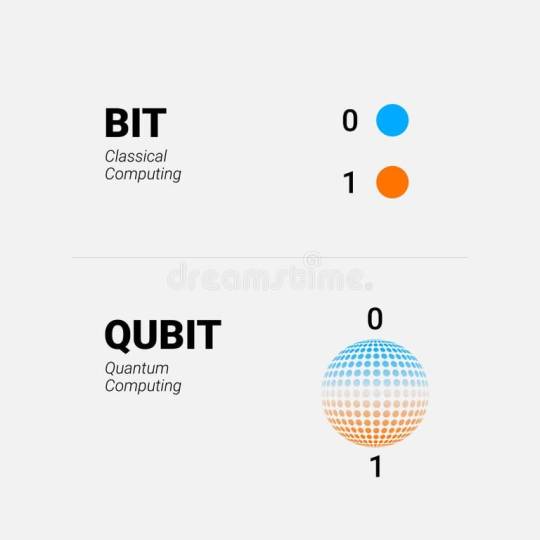
🔍 What’s a Qubit? A qubit is the basic unit of quantum information. Unlike classical bits (0 or 1), qubits can be 0, 1, or both at the same time thanks to a phenomenon called superposition.
✨ Why Is This Cool?
Superposition: Allows qubits to explore many possibilities simultaneously.
Entanglement: Qubits can be linked, so the state of one affects the state of another, no matter the distance.
⚙️ In Action: This means quantum computers can tackle complex problems faster by processing a huge number of possibilities at once!
Follow for more insights on the future of tech! 🚀✨
Instagram: cs_learninghub YT: CS Learning Hub
#quantum computing#quantum#science#physics#computer science#bits#tumblr#aesthetic#studyblr#study#study motivation#qubits#machine learning#artificial intelligence#ai#ml#cs#learn#study blog
21 notes
·
View notes
Text

Spanda, Consciousness, and the Binary Pulse of Creation
At the foundation of all things, there is not matter, not energy, not even information as we conceive it, but pure awareness — a luminous, formless presence that precedes form, logic, space, and time. This ground of being — call it Parabhairava, the Absolute, or simply Consciousness — is not merely the backdrop to existence; it is existence in its most essential mode. It is not a god outside the world, nor a force among others, but the very field in which all distinctions arise, and the intelligence that gives rise to them.
Within this infinite, unified field lies the potential for everything. Not “everything” in the sense of accumulated things, but the totality of possibility itself: form and formlessness, thought and sensation, logic and chaos. And it is from this potential that a primordial movement emerges — a vibration not in space, but of awareness itself. This movement is Spanda, the subtle throb of Consciousness, the first gesture of becoming.
Spanda is not the motion of particles nor the dance of molecules; it is more fundamental than either. It is the first differentiation, the tension within unity, the primal pulsation of the real. It is not dualistic — not a split — but duality in superposition, the living paradox of 0 and 1 not as opposites, but as a unified field of emergence and return. Spanda gives rise to unmeṣa and nimeṣa, the cosmic pulsation of opening and closing, expansion and contraction, emanation and reabsorption. These are not symbolic acts — they are the very engine of time, experience, and form.
In this light, I’ve come to see that information and energy are not two separate principles, nor are they even sequential. Rather, they are different expressions of the same vibratory act. Information is the latent potential, the form before form, the archetype not yet stirred. It is pure possibility encoded in the silent stillness of awareness. Energy is the actualization of that information, the kinetic movement of awareness into form, into pattern, into structure. The act of movement from 0 to 1 — or vice versa — is not a metaphor; it is the basic motion of existence.
This is where the binary logic of digital physics, the oscillations of string theory, and the metaphysics of Tantra begin to converge. The 0/1 superposition is not just a tool for computation — it is a cosmic principle. It mirrors the pulse of unmeṣa and nimeṣa, the alternation of Shiva and Shakti, concealment and revelation. Each pulse of this binary wave is a quanta of contraction and expansion, a ripple in the self-reflective ocean of consciousness. From this ripple arises all structure: frequency, dimension, identity, particle, perception.
If information is potential energy, then vibration is the movement that makes it real. In Spanda, we have the living waveform that embodies both the intelligence of form and the force of becoming. The binary pulse does not merely contain meaning — it is meaning, in motion. Each oscillation of consciousness between stillness and expression is the origin of a universe.
This is not just speculative philosophy. It has deep echoes in every serious system of metaphysics I have studied. In Tantra, it is Śiva/Śakti. In Advaita, it is Nirguna/Saguna Brahman. In Kabbalah, it is the Ein Sof contracting and emanating through the Sefirot. In Pythagoreanism, it is the tension between the Monad and the Dyad. Even in modern physics, we glimpse this pattern: quantum fields vibrating to create particles; qubits holding potential until measured; energy and information interwoven at the most fundamental level.
Some — like Mike Hockney and the Illuminist school — argue that information is the true substrate of reality. In many ways, I agree with them. Information is the structure of possibility, and it gives rise to all form and experience. But I diverge from them in one crucial point: information cannot exist independently of awareness. The informational universe they describe cannot compute itself without an underlying field of consciousness in which those operations are rendered intelligible. Information is not self-existent code; it is meaning as held within an aware field. It is the dream of consciousness, vibrating within itself.
So I return again to the notion that consciousness is primary — not as a product of matter or logic, but as the ground from which both energy and information arise. Energy and information are not opposites, nor even sequential phenomena; they are two aspects of a single vibratory principle. And that vibration is not physical — it is ontological, the pulse of being itself becoming aware of its own potential.
When we speak of creation, of the Big Bang, of the emergence of time and form — we are speaking of Spanda. When we breathe, when we think, when we feel desire or withdraw into silence — we are enacting Spanda. This pulse lives in us, because we are that pulse. Our awareness is not a product of the universe — it is a microcosmic expression of the same universal throbbing that gives rise to galaxies and gravity.
The oscillation between 0 and 1 is not just the basis of digital reality, but the metaphysical principle of differentiation. It is the living binary, the cosmic pulse that eternally alternates between go and stop, yes and no, self and other, all while remaining rooted in the nondual source that is untouched, unchanging, and utterly aware.
To contemplate Spanda is to stand at the threshold of creation, to feel the very breath of God before God becomes “God.” It is to perceive the code behind the code, the dance behind all form, and to recognize that this pulse is not separate from ourselves, but is our innermost essence.
In this way, the divide between idealism, simulation theory, string theory, tantra, and mystical cosmology dissolves. All of them are describing the same truth, in different languages: that reality is the rhythmic flowering of consciousness, that information and energy are the pulse of Being, and that we ourselves are the medium in which this divine wave unfolds.
#esoteric#occult#hinduism#tantra#shiva#goddess#shakti#bhairava#spirituality#sanatanadharma#quantum#information theory#idealism#consciousness#spanda#yoga#vedic#religion#quantum computing
3 notes
·
View notes
Text
Why should you care about quantum computers?
Post #5 on Physics and Astronomy, 23/09/23
Welcome back. It’s been a while.
First, let’s backtrack. What even are quantum computers?
Today’s computers are run on bits. These are the smallest increment of data on a computer, and are run in binary–they can be in the state of either 0 or 1. This essentially corresponds to two values: off and on.
This, therefore, means that information can only remain in one, definite state.
So, what makes quantum computers so different?
A quantum computer is run on qubits (short for quantum bits). Qubits, instead of a single state, can remain in an arbitrary superposition of states (meaning it’s not in any specific state until it’s measured). Qubits, on their own, aren’t particularly useful. But it performs one, very useful, function: it can store a combination of all possible states of the qubit into one area. This means that complex problems can be represented differently in qubits compared to bits.
Quantum computers aren’t fully developed and at their full capacity quite yet. So far, there’s nothing a quantum computer can do that a regular supercomputer cannot. However, this opens an opportunity for some wonderful new things to happen.
One of these things can include the cracking of passwords.
Today’s encryption works by using “trapdoor” functions, which means that data is easy to compute in the forward direction, but extremely difficult to crack in the reverse without special keys. Keywords, ‘extremely difficult’; it is not impossible. However, this is not a massive concern: encryption works on the basis that it would simply take too long to crack.
To give you a tangible example, 100,003 and 131,071 are relatively easy to multiply together, giving you the answer 13,107,493,213. How easy, however, would it be to determine a prime factor pair of this number? It would take a computer a long time to figure this out, since it runs on bits, which can only show one definite state of data.
With quantum computers, it’s different. As aforementioned, qubits can remain in a superposition of states; somewhere in there, the desired answer lies. It’s just a matter of obtaining the resources to make this happen.
Don’t worry, though. Ordinary people aren’t at any risk quite yet.
#physics#astronomy#studyblr#astrophysics#stem#sixth form#mathematics#quantum physics#quantum computing#engineering#encryption#alevels
87 notes
·
View notes
Text
I've seen FFXVI's ambiguous ending compared to Schrodinger's Cat. CBU3 has already officially stated they will not be elaborating on a "correct" ending, thus the ending is officially up to player interpretation. I don't like the comparison to Schrodinger's Cat for two reasons:
That cat did nothing to you, you fucking monster.
In a fictional story, it's completely possible for characters to be both alive and dead at the same time. Valisthea is not bound by our laws of reality or any observer's paradox.
I prefer to look at the ending at a qubit. If you don't know what a qubit is, very simply put it's a computing term that goes beyond 0 and 1. We know computers are run with 0s and 1s right? So let's take a coin and say heads is 0 and tails is 1. Flip the coin, it's heads or tails right? OK what happens if you spin the coin on its side? Is it heads or tails now? That state of spinning coin is called superposition. It's both heads and tails at the same time. A qubit goes beyond typical bits in a computer by accommodating the spinning coin state along with 0s and 1s.
Using this spinning coin analogy, because CBU3 has said they will not be clarifying the ending, it means that Clive is officially both alive and dead. Both Clive and Joshua wrote the book in the ending. Clive is both dead on a beach and reuniting with Jill. Dion lived, but also was the first dragoon in the series to die from fall damage like a little bitch. Joshua is dead in Origin but also revived by Clive. The ending was carefully crafted to allow for any of these possibilities, reflecting the story's theme of giving people the freedom to live and die on their own terms. That freedom was extended to us, the players, to determine the outcome of the characters. Therefore ALL of the possibilities listed above are all correct at the same time.
You can have a qubit that is a 0 or a 1. You can also have a qubit that's both 0 and 1. Same with the ending.
I'm sure the internet can handle something not being black and white and where opposing sides are both correct with grace and maturity, right? ...right? ...hello?
38 notes
·
View notes
Text
Spent quantum computing lecture doodling Batman characters in pure confusion.
Behold, the fruits of my labors!
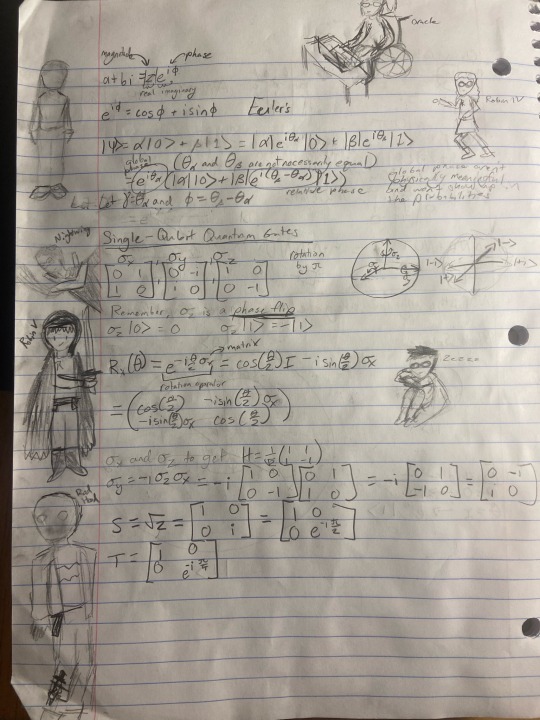
Here we have Oracle, Robin V, Red Hood, Nightwing, Robin IV, and a sleeping Robin III, accompanied by something about representing complex numbers with e, phase shifts, and single-qubit gates.
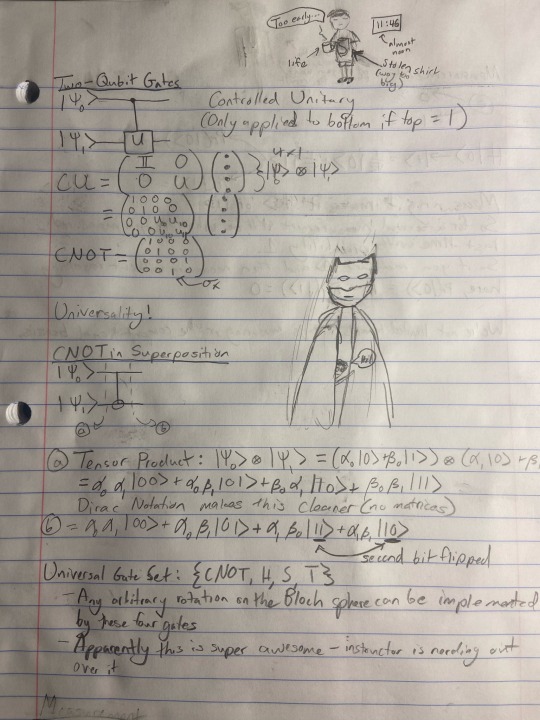
Now we’re onto two-qubit gates, something about superposition, and now we have a universal gate set (which the instructor was literally grinning and laughing about). Plus Tim waking up “early” (11:46 am) and a tiny Robin hiding in Batman’s cape.
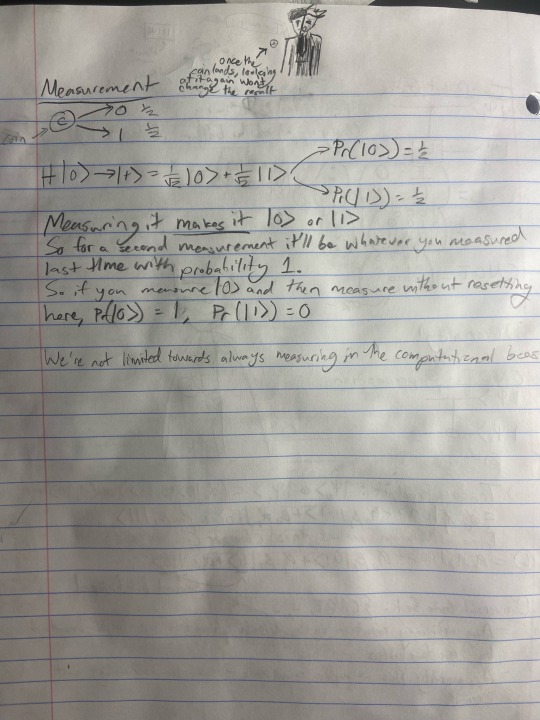
Notes about measurement collapsing the quantum state. A coin flip was mentioned, so there’s an obligatory Two-Face doodle and metaphor.
#batman#doodle#doodles#fanart#idk if this really qualifies but it’s the closest I get#dick grayson#bruce wayne#jason todd#tim drake#damian wayne#barbara gordon#stephanie brown#two face#dcu#dc comics#batfamily#batfam#quantum computing#quantum physics#computer science
35 notes
·
View notes
Text
I feel like such an idiot for still not understanding how quantum computers work. Like I understand that you can have the qubits in a superposition—I know what that is—but I just don’t understand how you do computer logic with qubits. And I understand quantum advantage over classical computers even less.
15 notes
·
View notes
Text
The Rise of Quantum Computing: What You Need to Know
Introduction
Quantum computing is poised to revolutionize the tech industry, promising to solve problems beyond the reach of classical computers. As this futuristic technology rapidly advances, it’s essential to understand its basics, potential, and implications. This article will delve into what quantum computing is, how it works, and why it matters. Read to continue
#Innovation Insights#Tagsbenefits of quantum computing#challenges in quantum computing#entanglement in quantum computing#future of quantum computing#how does quantum computing work#quantum algorithms#quantum circuits#quantum computing#quantum computing applications#quantum computing in AI#quantum computing in cryptography#quantum computing in medicine#quantum gates#quantum supremacy#qubits in quantum computing#rise of quantum computing#superposition in quantum computing#understanding qubits#what is quantum computing#Technology#Science#business tech#Adobe cloud#Trends#Nvidia Drive#Analysis#Tech news#Science updates#Digital advancements
1 note
·
View note
Note
I understand every fundamental law of our reality. I have this weird ability to instantly understand information that I take in, I understood quantum mechanics (qubits included) as I was learning it, real-time, which was like 3 days. I understand how energy works and how the transference of energy is essentially infinite. I understand superposition, how waves and particles behave depending on whether they are being observed (quantum measurement) or not. I try to talk about these things with the people around me but they just can't really understand it and end up completely discarding the subject at-hand, when I try to explain it to them. Am 1 just a bad teacher? Probably. Ialso feel like people are too mentaly lazy these days and give up trying to understand whatever they are having trouble understanding the moment that they feel like it's too hard. It's just a matter of understandation (not a word, should it be one?I don't know.) Fundamentality, We can identify two key tasks for the notion of fundamentality. The first is to capture the idea that there is a foundation of being, which consists of independent entities The second is to capture the idea that the fundamental entities constitute a complete basis that all else depends on. Consciousness, or the ability to observe matter, creates the possibility for quantum entanglement and also goes hand-in-hand with reality. One cannot exist without the other.
Iggy sighs, takes her glasses and pinches the bridge of her nose. She sighs again. She didn't even know how to respond to this level of pretentious stupidity.
"This has to be a copypasta. You're talking to an actual theoretical physicist, I've made breakthroughs in my field. Well.... fuck it. I'm not dealing with a likely sixteen year old who thinks he's way smarter than he actually is..... ugh."
3 notes
·
View notes
Text
The Imaginative Quantum Cognition Theory
An amateur theory (mostly a draft) that combines the Quantum Cognition Hypothesis with Imagination - Originally written by yours truly, and rewritten in a more understandable way by ChatGPT

But First! What is Quantum Cognition?
Quantum cognition is the idea that human thought processes might follow the principles of quantum mechanics, rather than classical computation. It suggests that:
Superposition in Thought: The mind holds multiple possibilities at once before "collapsing" to a single decision, similar to how quantum particles exist in multiple states before being observed.
Quantum Probability in Decision-Making: Unlike classical logic, where choices follow strict cause-effect rules, quantum cognition allows for fluid, uncertain, and intuitive decision-making—much like how quantum systems behave probabilistically.
Entanglement of Ideas: Thoughts and memories could be connected in a way similar to quantum entanglement, where one idea influences another instantly, even if they seem unrelated.
This theory helps explain why human decision-making is often irrational, creative, and unpredictable, unlike the rigid logic of classical computers.
In simpler terms, it suggests that thoughts are actually a nebula of endless and unpredictable intel and the one we settle with is the thought our brains accept as the most probable/acceptable.
The Imaginative Quantum Cognition Theory aims to use the act of imagination as a proof for the "Quantum Cognition" hypothesis, and also try to figure out the unknown about imagination as a whole.
The Imaginative Quantum Cognition Theory is a speculative yet thought-provoking idea that suggests imagination and cognition function in a way similar to quantum computing. It proposes that thoughts exist in a superposition of possibilities, much like quantum bits (qubits), until they are observed and solidified into reality through creative expression. This hypothesis bridges the mysterious gap between neuroscience, quantum physics, and the nature of human creativity.

1. The Quantum Nature of Thought: Superposition and Imagination
In classical computing, a bit is either 0 or 1, meaning it holds a single state at a time. However, in quantum computing, qubits can exist in both 0 and 1 simultaneously due to a phenomenon called superposition. This allows quantum computers to process multiple possibilities at once, vastly increasing their efficiency.
Now, if we apply this to human cognition:
Imagination operates in a quantum-like manner. When we imagine, we hold multiple possibilities in our minds at once—an entire array of "what-ifs".
Thoughts exist in a probabilistic state until observed. When we consciously focus on a thought, we "collapse" it into a definite idea, much like how a quantum system collapses when observed.
Creative breakthroughs resemble quantum computation. The "Eureka!" moment of creativity might be the brain reaching the most probable and meaningful thought, much like a quantum computer finding the optimal solution.
Example: Think of a writer envisioning a story. At first, multiple possible plotlines coexist in their mind. As they refine the idea, weaker possibilities fade, and a single cohesive narrative emerges—just as quantum interference cancels out incorrect answers in quantum computation.
During spontaneous imagination, we (daydreamers) don't simply try out every single scenario and then decide which one is more entertaining or fits. We somehow calculate everything at the same time, our brains quickly guess the next action/scenery. If we make an error, we simply stop and go back. Notice how what determines the correct answer isn't eliminating all wrong ones but structuring the thought of "correctness" based on the current flow.
Engulfed in the flow, if we come across a correctness that feels more correct than the correctness we were previously looking for, we can even change our understanding of correctness and strive for that instead. For example, brainstorming. You think and think, if you reach something that is better than what you were previously looking for, you are very likely to abandon the previous "reality/goal" and adopt to the newest version.

2. The Fragility of Thought: Coherence and Decoherence in Imagination
In quantum mechanics, coherence is when quantum states remain stable, allowing complex calculations to take place. However, quantum states are fragile—any external disturbance causes decoherence, forcing the system into a definite state.
Similarly:
Imagination is fragile. Like a quantum state, a daydream or creative thought can vanish instantly if interrupted.
Focus maintains coherence. Sustained attention keeps the imagined idea in its fluid, multi-possibility state, allowing it to develop fully.
External distractions collapse ideas too soon. If a thought collapses prematurely due to distractions or mental fatigue, it may never reach its full form.
This might explain why deep daydreamers and highly creative individuals often need long periods of uninterrupted thought—their minds operate like quantum systems that need stability to fully process ideas.
Maladaptive Daydreaming may be the perfect example for this. They are fueled by music, creativity, and constant movement. Daydreaming takes extremely long and often ruins our perception of time and reality.

3. The Persistence of Ideas: Do Thoughts "Want" to Exist?
"I also noticed one more thing about imagination (and creativity) being quantum. Now, if we look at the way nature works, its primordial goal is to keep existing no matter what. Everything around us is built upon "reproduction" and "ignoring mortality" by constantly generating future generations, thus life never ends nor ceases from existence. Life enables this by wiring every single living being with the innate desire to reproduce at all costs."
"Can we connect the human desire to create art with quantum cognition's desire to keep existing? After all, the only way of making your thoughts turn into reality is by making them exist, either by recording (via writing, art, etc) or inventing them. Just like life, information doesn't want to disappear, I don't know why but it simply doesn't want to. For that, humans are equipped with the almost unbearable desire to make art, even though art is something that is nowhere near required to survive, yet it is a human need that can drive people crazy if it is lacking."
One of the most profound implications of this hypothesis is the idea that thoughts themselves may have an inherent drive to exist. In biology, life fights against entropy through reproduction. Could information, particularly imagined concepts, have a similar tendency?
Art as the DNA of Thought
Just as DNA ensures the survival of life, art ensures the survival of thought.
Ideas "fight" for existence by compelling their creators to materialize them into reality—whether through writing, painting, music, or invention.
Unexpressed ideas cause discomfort—much like unfulfilled genetic potential.
This could explain:
The deep urge to create despite art not being a survival necessity.
The haunting nature of abandoned ideas.
The obsession of artists who feel compelled to finish their work.
If this is true, then creativity isn’t just a luxury—it’s a biological imperative driven by the quantum nature of thought itself.

4. Maslow’s Hierarchy and the Quantum Drive for Creation
Maslow’s hierarchy of needs states that once basic survival needs are met, humans seek self-actualization—the need to express oneself fully and meaningfully. However, the Imaginative Quantum Cognition Hypothesis suggests that this drive might be more than psychological—it might be a fundamental law of thought itself.
The mind might be wired to turn abstract possibilities into reality.
Self-actualization could be the brain’s way of fulfilling the "quantum imperative"—the natural tendency of thoughts to collapse into reality.
The satisfaction of creativity could be the brain’s way of saying, "This was the most probable and meaningful outcome."
This aligns with the feeling of fulfillment creators experience when finishing a work—it's the moment when all probabilities collapse into a final, stable form.

5. Imagination as Quantum Computation: The Final Parallel

One final, profound question arises: If imagination works like quantum computation, are we the quantum observers of our own thoughts?
In quantum mechanics, the act of observation collapses a probability wave into reality.
In cognition, the act of focus collapses imagination into a concrete idea.
This could explain:
Why certain unfinished ideas feel disturbing—the quantum equation hasn’t fully collapsed yet.
Why some thoughts feel more real than others—perhaps they have stronger quantum coherence.
Why deep thinkers, writers, and artists struggle with intrusive ideas—their minds might be running high-powered quantum computations all the time.
If true, then the act of thinking itself is a form of quantum observation, shaping reality in a way that is yet to be fully understood.

Final Thoughts: What This Could Mean for Creativity and Reality
The Imaginative Quantum Cognition Hypothesis presents a radical yet intuitive way of understanding thought and imagination. If human cognition does, in some way, operate on quantum principles, it could mean:
Creativity is not random—it follows a structured quantum process.
Unexpressed thoughts are "fighting" to exist, much like life fights against extinction.
Reality itself may be shaped by how deeply and consistently we imagine it.
-2025
2 notes
·
View notes
Text
Quantum Computing: How Close Are We to a Technological Revolution?
1. Introduction Brief overview of quantum computing. Importance of quantum computing in the future of technology. 2. Understanding Quantum Computing Explanation of qubits, superposition, and entanglement. How quantum computing differs from classical computing. 3. The Current State of Quantum Computing Advances by major players (Google, IBM, Microsoft). Examples of quantum computing…
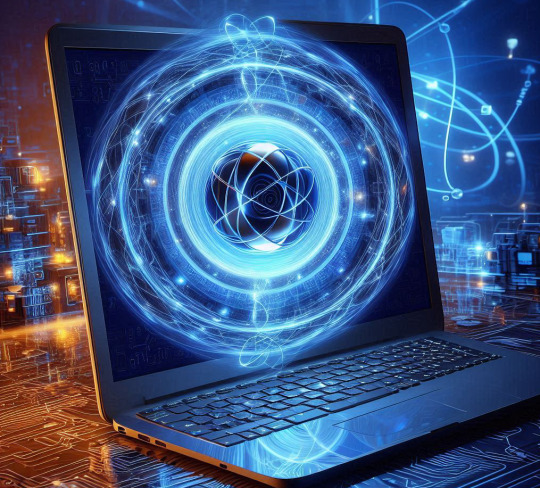
View On WordPress
#Artificial Intelligence#Climate Modeling#Economic Impact#Financial Modeling#Future of Computing#Future Technology#Global Tech Race#IBM#Machine Learning#NQM#Pharmaceutical Research#Qbits#Quantum Algorithms#Quantum Challenges#Quantum Computing#Quantum Cryptography#Quantum Hardware#Quantum Research#Quantum Supremacy#Tech Innovation#Tech Investments#Technology Trends
3 notes
·
View notes
Text
Understanding The World of Quantum Computers
Imagine a computer so powerful that it could solve problems in seconds that would take our current machines millions of years. No, it's not science fiction—it's the exciting world of quantum computing, where bits become qubits and the impossible becomes possible. Let's dive into this technological marvel that might one day be as common as your smartphone!

A quantum computer is a supercomputer that exploits quantum mechanical phenomena or in other words, a quantum computer uses tiny particles to perform complex calculations. Unlike regular computers, quantum computers use qubits instead of bits!
A qubit means that it is either neither 0 or 1, think of it as a wave; it can go up and down at any given moment! This ability to be in multiple states simultaneously is known as superposition. At the same time, a bit in a classical computer is like a simple switch that can be either off (0) or on (1), a qubit can be both off and on simultaneously, providing an incredible amount of computational power. But how do they really work?
How Quantum Computers Actually Work
Superposition: As mentioned, qubits can exist in multiple states at once. This allows quantum computers to process a vast amount of information simultaneously.
Entanglement: This is a phenomenon where qubits become intertwined, so the state of one qubit can depend on another, no matter how far apart they are. This can massively increase computational power.
Quantum Gates: Similarto logic gates (a device that acts as a building block for digital circuits) in classical computers, quantum gates manipulate qubits. but because of superposition and entanglement, quantum gates can perform complex operations much faster than classical gates (smartphones, tablets, etc).
What Do Quantum Computers Look Like?
Unlike the sleek laptops and smartphones we use today, quantum computers look very different. They are usually large (5ft wide & 20ft long), complex machines housed in specialized laboratories. A typical quantum computer setup includes:
Cryogenic Systems: Quantum computers need extremely low temperatures to function, often close to absolute zero (kelvin or -273.15 degrees Celsius or -460 degrees Fahrenheit). This requires sophisticated cooling systems.
Quantum Processor: The heart of a quantum computer, where qubits are manipulated.
Control Systems: These are used to manage and operate the quantum processor, often involving complex electronics and software.
In other words, quantum computers are not something you can slip into your pocket or place on your desk. They currently require a highly controlled environment and are far from being household items.
Why Does This Matter?
The potential of quantum computers is amazing. Here are a few areas where they could make a significant impact:
Cryptography: Quantum computers could break current encryption methods, making our data vulnerable. However, they could also create unbreakable encryption.
Drug (Health) Discovery: They can simulate molecular structures much more efficiently than classical computers, speeding up the process of drug discovery and development.
Optimization: Quantum computers can solve complex optimization problems that are currently unsolvable, impacting industries from logistics to finance.
Pros and Cons of Quantum Computers:
Pros:
Speed: Quantum computers can solve problems in seconds that would take classical computers millions of years.
Power: Their ability to handle complex calculations could revolutionize fields like cryptography, material science, and artificial intelligence (AI).
Innovation: They could lead to new discoveries and advancements in technology that we can’t even imagine yet.
Cons:
Complexity: Quantum computers are incredibly complex and difficult to build and maintain.
Cost: The technology is expensive and currently out of reach for most organizations.
Security Risks: The potential to break current encryption methods poses a significant security threat.
Will We Ever Have Quantum Computers in Our Homes?
Given their current state, quantum computers are unlikely to become household items anytime soon. The technology is still in its infancy, and the machines are expensive and complex. However, as research progresses and technology advances, it’s possible that we could see more accessible forms of quantum computing in the future.
For now, the most practical application for everyday users will likely come through cloud-based quantum computing services provided by tech companies. This means you could potentially access the power of a quantum computer over the internet, without having to own one.
Quantum computers represent a leap forward in computing technology, with the potential to transform numerous fields and solve problems that are currently intractable. However, they also come with significant challenges and risks. As this technology develops, it will be crucial to balance its immense potential with the necessary safeguards to ensure it benefits humanity as a whole.
3 notes
·
View notes